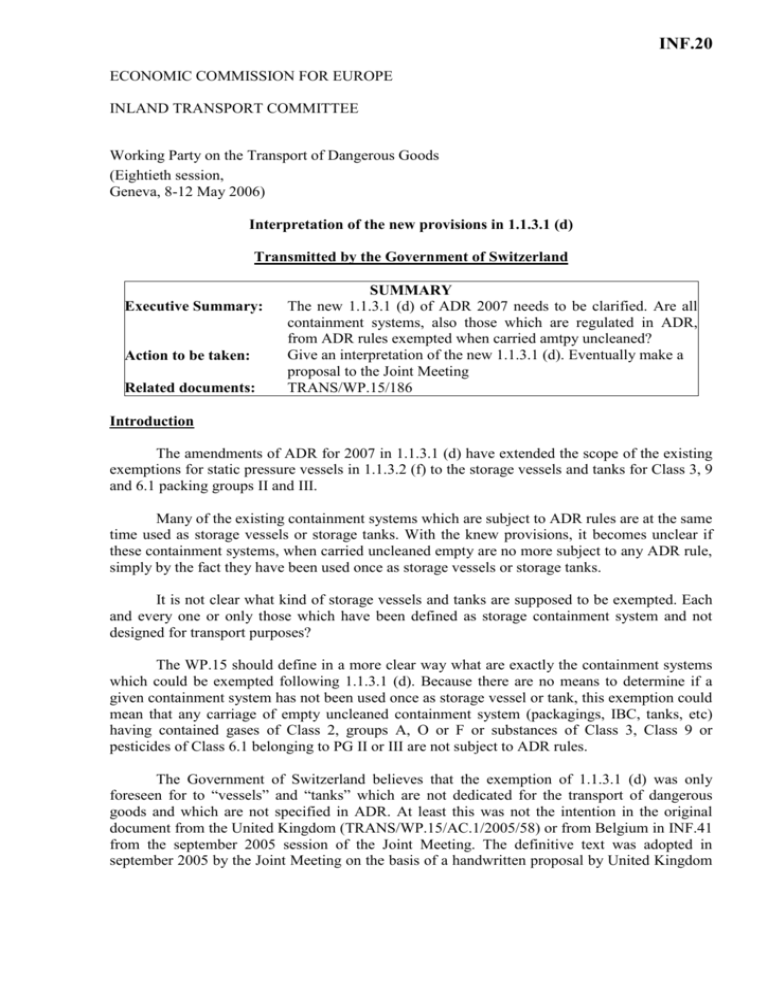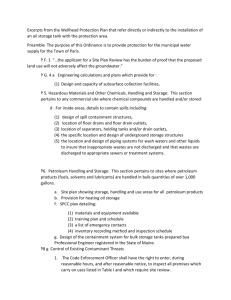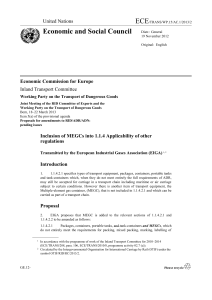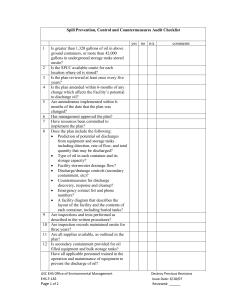Working Party on the Transport of Dangerous Goods
advertisement

INF.20 ECONOMIC COMMISSION FOR EUROPE INLAND TRANSPORT COMMITTEE Working Party on the Transport of Dangerous Goods (Eightieth session, Geneva, 8-12 May 2006) Interpretation of the new provisions in 1.1.3.1 (d) Transmitted by the Government of Switzerland Executive Summary: Action to be taken: Related documents: SUMMARY The new 1.1.3.1 (d) of ADR 2007 needs to be clarified. Are all containment systems, also those which are regulated in ADR, from ADR rules exempted when carried amtpy uncleaned? Give an interpretation of the new 1.1.3.1 (d). Eventually make a proposal to the Joint Meeting TRANS/WP.15/186 Introduction The amendments of ADR for 2007 in 1.1.3.1 (d) have extended the scope of the existing exemptions for static pressure vessels in 1.1.3.2 (f) to the storage vessels and tanks for Class 3, 9 and 6.1 packing groups II and III. Many of the existing containment systems which are subject to ADR rules are at the same time used as storage vessels or storage tanks. With the knew provisions, it becomes unclear if these containment systems, when carried uncleaned empty are no more subject to any ADR rule, simply by the fact they have been used once as storage vessels or storage tanks. It is not clear what kind of storage vessels and tanks are supposed to be exempted. Each and every one or only those which have been defined as storage containment system and not designed for transport purposes? The WP.15 should define in a more clear way what are exactly the containment systems which could be exempted following 1.1.3.1 (d). Because there are no means to determine if a given containment system has not been used once as storage vessel or tank, this exemption could mean that any carriage of empty uncleaned containment system (packagings, IBC, tanks, etc) having contained gases of Class 2, groups A, O or F or substances of Class 3, Class 9 or pesticides of Class 6.1 belonging to PG II or III are not subject to ADR rules. The Government of Switzerland believes that the exemption of 1.1.3.1 (d) was only foreseen for to “vessels” and “tanks” which are not dedicated for the transport of dangerous goods and which are not specified in ADR. At least this was not the intention in the original document from the United Kingdom (TRANS/WP.15/AC.1/2005/58) or from Belgium in INF.41 from the september 2005 session of the Joint Meeting. The definitive text was adopted in september 2005 by the Joint Meeting on the basis of a handwritten proposal by United Kingdom INF.20 page 2 in INF 69. If our interpretation is right, a sentence similar as the one of 1.1.3.1 (b) should be introduced saying for example: 1.1.3.1 Add a new sub paragraph (f) to read: "(f) the carriage of uncleaned empty static or storage vessels and tanks, not specified in this Annex, which have contained gases of Class 2, groups A, O or F, substances of Class 3 or Class 9 belonging to packing group II or III or pesticides of Class 6.1 belonging to packing group II or III, subject to the following conditions: In doing so we exclude of the exemption all containment systems which usually don’t need to be fully exempted from the rules because the already fullfil the ADR requirements. If this is the interpretation of the majority of the WP.15 such proposal could be presented to the next Joint Meeting. If this is not the intention of the WP.15, then something about the scope of the the exemption could be put in the report. This would represent a fundamental change in the carriage of ADR-empty uncleaned containment systems adopted during a session on the basis of an handwritten proposal. _________








